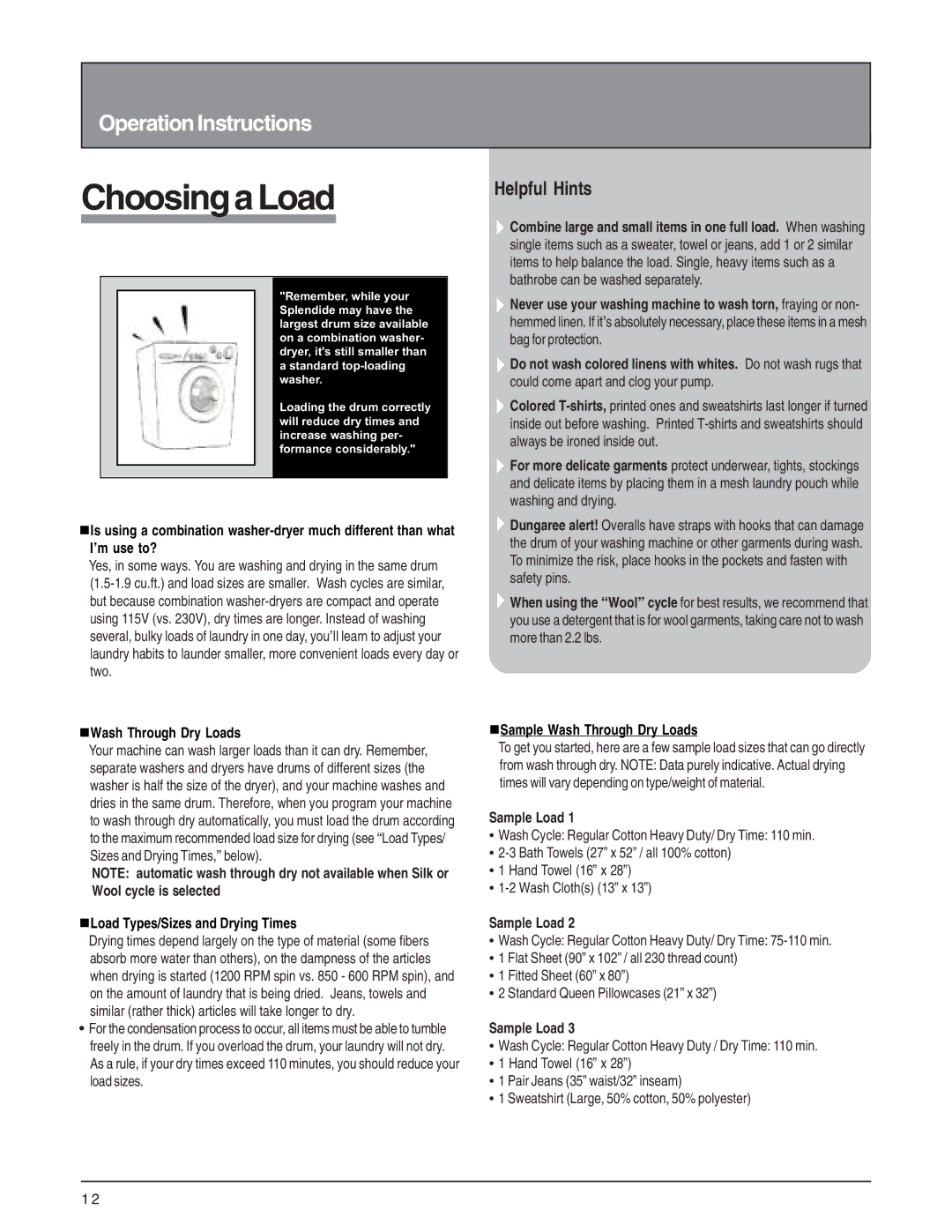
Operation Instructions
Choosing a Load
"Remember, while your Splendide may have the largest drum size available on a combination washer- dryer, it's still smaller than a standard
Loading the drum correctly will reduce dry times and increase washing per- formance considerably."
nIs using a combination
I’m use to?
Yes, in some ways. You are washing and drying in the same drum
nWash Through Dry Loads
Your machine can wash larger loads than it can dry. Remember, separate washers and dryers have drums of different sizes (the washer is half the size of the dryer), and your machine washes and dries in the same drum. Therefore, when you program your machine to wash through dry automatically, you must load the drum according to the maximum recommended load size for drying (see “Load Types/ Sizes and Drying Times,” below).
NOTE: automatic wash through dry not available when Silk or Wool cycle is selected
nLoad Types/Sizes and Drying Times
Drying times depend largely on the type of material (some fibers absorb more water than others), on the dampness of the articles when drying is started (1200 RPM spin vs. 850 - 600 RPM spin), and on the amount of laundry that is being dried. Jeans, towels and similar (rather thick) articles will take longer to dry.
•For the condensation process to occur, all items must be able to tumble freely in the drum. If you overload the drum, your laundry will not dry. As a rule, if your dry times exceed 110 minutes, you should reduce your load sizes.
Helpful Hints
![]() Combine large and small items in one full load. When washing single items such as a sweater, towel or jeans, add 1 or 2 similar items to help balance the load. Single, heavy items such as a bathrobe can be washed separately.
Combine large and small items in one full load. When washing single items such as a sweater, towel or jeans, add 1 or 2 similar items to help balance the load. Single, heavy items such as a bathrobe can be washed separately.
![]() Never use your washing machine to wash torn, fraying or non- hemmed linen. If it’s absolutely necessary, place these items in a mesh bag for protection.
Never use your washing machine to wash torn, fraying or non- hemmed linen. If it’s absolutely necessary, place these items in a mesh bag for protection.
![]() Do not wash colored linens with whites. Do not wash rugs that
Do not wash colored linens with whites. Do not wash rugs that
could come apart and clog your pump.
![]() Colored
Colored
![]() For more delicate garments protect underwear, tights, stockings and delicate items by placing them in a mesh laundry pouch while washing and drying.
For more delicate garments protect underwear, tights, stockings and delicate items by placing them in a mesh laundry pouch while washing and drying.
![]() Dungaree alert! Overalls have straps with hooks that can damage the drum of your washing machine or other garments during wash. To minimize the risk, place hooks in the pockets and fasten with safety pins.
Dungaree alert! Overalls have straps with hooks that can damage the drum of your washing machine or other garments during wash. To minimize the risk, place hooks in the pockets and fasten with safety pins.
![]() When using the “Wool” cycle for best results, we recommend that you use a detergent that is for wool garments, taking care not to wash more than 2.2 lbs.
When using the “Wool” cycle for best results, we recommend that you use a detergent that is for wool garments, taking care not to wash more than 2.2 lbs.
nSample Wash Through Dry Loads
To get you started, here are a few sample load sizes that can go directly from wash through dry. NOTE: Data purely indicative. Actual drying times will vary depending on type/weight of material.
Sample Load 1
•Wash Cycle: Regular Cotton Heavy Duty/ Dry Time: 110 min.
•
•1 Hand Towel (16” x 28”)
•
Sample Load 2
•Wash Cycle: Regular Cotton Heavy Duty/ Dry Time:
•1 Flat Sheet (90” x 102” / all 230 thread count)
•1 Fitted Sheet (60” x 80”)
•2 Standard Queen Pillowcases (21” x 32”)
Sample Load 3
•Wash Cycle: Regular Cotton Heavy Duty / Dry Time: 110 min.
•1 Hand Towel (16” x 28”)
•1 Pair Jeans (35” waist/32” inseam)
•1 Sweatshirt (Large, 50% cotton, 50% polyester)
1 2
